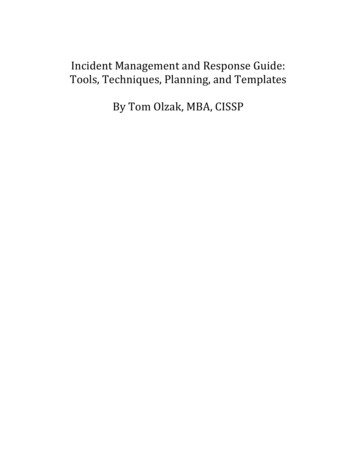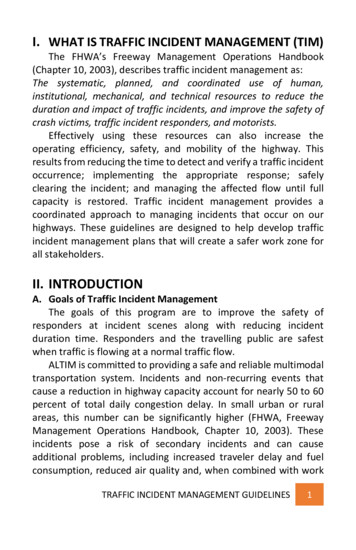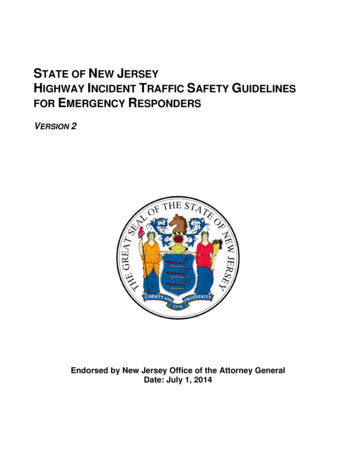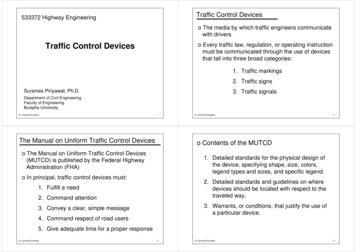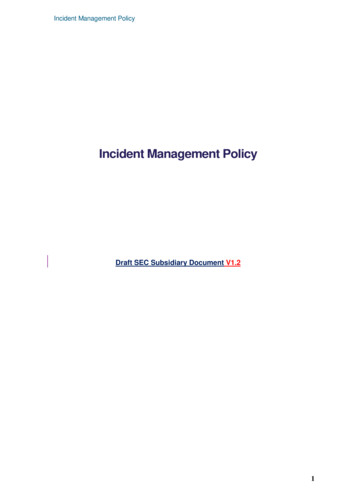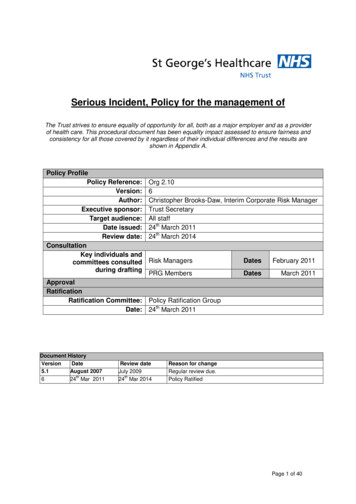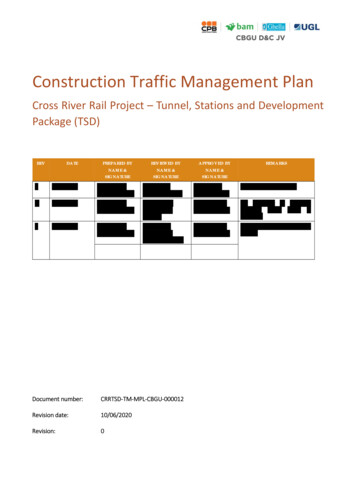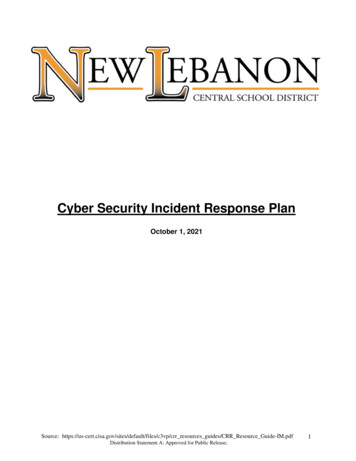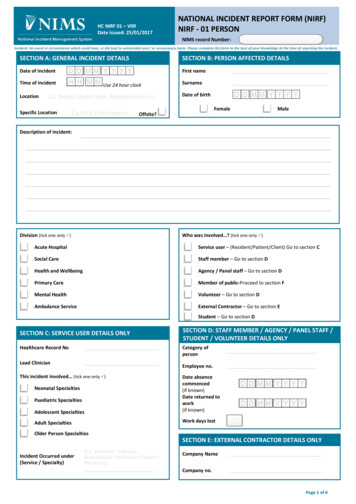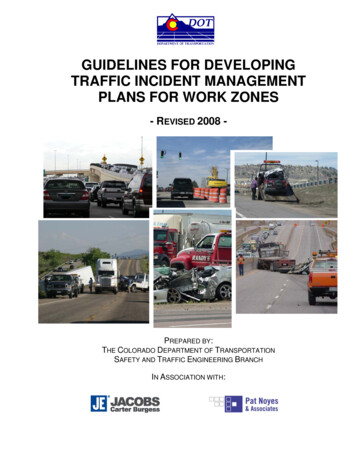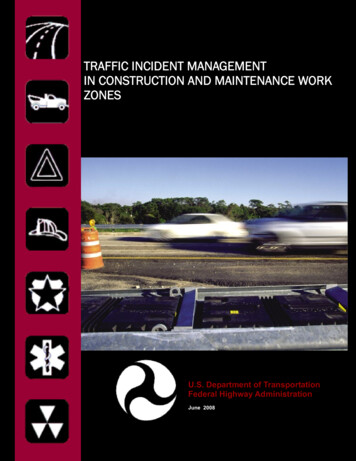
Transcription
TRAFFIC INCIDENT MANAGEMENTIN CONSTRUCTION AND MAINTENANCE WORKZONESU.S. Department of TransportationFederal Highway AdministrationJune 2008
QUALITY ASSURANCEThe U.S. Department of Transportation provides high-quality information to serveGovernment, industry, and the public in a manner that promotes publicunderstanding. Standards and policies are used to ensure and maximize the quality,objectivity, utility, and integrity of its information. USDOT periodically reviews qualityissues and adjusts its programs and processes to ensure continuous qualityimprovement. This material is based upon work supported by the Federal HighwayAdministration under contract number DTFH61-06-D-0007. Any opinions, findingsand conclusions or recommendations expressed in this publication are those of theauthor(s) and do not necessarily reflect the views of the Federal HighwayAdministration.i
Technical Report Documentation Page1. Report No.2. Government Accession No.3. Recipient's Catalog No.FHWA‐HOP‐08‐0564. Title and Subtitle5. Report DateTRAFFIC INCIDENT MANAGEMENT IN CONSTRUCTION ANDMAINTENANCE WORK ZONESMarch 20087. Author(s)8. Performing Organization Report No.6. Performing Organization CodeKevin Balke, Ph.D., P.E.9. Performing Organization Name and Address10. Work Unit No. (TRAIS)Texas Transportation InstituteThe Texas A&M University SystemCollege Station, Texas 77843-313511. Contract or Grant No.12. Sponsoring Agency Name and Address13. Type of Report and Period CoveredFederal Highway AdministrationOffice of Transportation OperationsTechnical ReportDTFH61-06-D-000714. Sponsoring Agency Code15. Supplementary NotesProject performed under contract to Battelle for the Federal Highway Administration Office of Operations16. AbstractIn 2004, the Federal Highway Administration published updated rules governing work zone safety and mobility; all highwayconstruction and maintenance projects using federal-aid highway funds are required to develop transportation management plans(TMP) focusing on safety and the reduction of traffic mobility impacts through coordination. The project TMP should consist of acollection of administrative, procedural, and operational strategies for managing and mitigating the impacts of work zones. It isimportant for planners, operations personnel, and incident responders to understand why the transportation operation elements arevital in the process of developing the TMP. This document addresses the special needs and concerns when managing trafficincidents within a work zone and focuses on incident management as a strategy to be considered in the transportation operationscomponent of the TMP. A description of techniques and strategies that can be used to handle incidents in work zones is presentedSome trend-setting approaches used on high-profile construction projects are also showcased as examples of good incidentresponse planning incorporated at the design level. The contractor’s role in dealing with incidents within the work zone isaddressed as well as the description of processes, procedures, and practices related to the detection, response, and clearance ofincidents. The importance of including incident management procedures as an element of the transportation operations componentof these plans is emphasized. The goals, objectives, and reasons for incident management as well as the issues and concerns thatwork zone planners, incident responders, and traffic operators need to consider in the planning phases of a work zone project arepresented. Common work zone incident management strategies are described.17. Key Words18. Distribution StatementTransportation Management Plans, Work Zones,Traffic Incident ManagementNo restrictions. This document is available to thepublic through NTIS:National Technical Information ServiceSpringfield, Virginia 22161http://www.ntis.gov19. Security Classif.(of this report)20. Security Classif.(of this page)21. No. of PagesUnclassifiedUnclassified68Form DOT F 1700.7 (8-72)Reproduction of completed page authorized59ii22. Price
iii
iv
TABLE OF CONTENTSQUALITY ASSURANCE ---------------- iTABLE OF CONTENTS ----------------- vLIST OF FIGURES -------------------- viLIST OF TABLES ---------------------- vi1.0INTRODUCTION --------------1Purpose of This Document ------------------------ 1Target ---------------------------------------------- 2Structure of This -------------------------------- 22.0TRANSPORTATION MANAGEMENT PLANS FOR WORK ZONES --------------5What is a Transportation Management ------ 5What are the Components of a Transportation Management Plan? ---------------------- 5Why is a Transportation Management Plan Needed? ---------------------------------------- 6When is a Transportation Management Plan Needed? -------------------------------------- 7Who Needs to be Involved in the Development of a Transportation ManagementPlan? -- 8What is the Process for Developing a Transportation Management Plan? -------------- 8Factors Impacting the Need for Work Zone Incident Management ------------------------ 93.0TRAFFIC INCIDENT MANAGEMENT CONCEPTS IN HIGHWAY WORKZONES ----------------------- 13Planning and Coordinating With Incident Response Agencies ----------------------------13The Incident Command System and Unified ssing the Need for Traffic Incident Management in Work Zones -------------------16The Planning TRUCTION STRATEGIES AND ACTIVITIES --------------------- 25Role of the Contractor/Construction Personnel in Work Zone Incident Management 25Institutional Arrangement and Agreements ---26Coordination with Existing Incident Management Programs -------------------------------26Alternate Route ----------------------------------27Training Information y and Legal Issues -------------------------335.0INCIDENT MANAGEMENT STRATEGIES AND TECHNIQUES FOR USEIN WORK ZONES ------------ 35Strategies and Techniques for Improving Incident Detection in Work Zones ----------35Strategies and Techniques for Improving Incident Response------------------------------38Strategies and Techniques for Improving Incident Clearance -----------------------------40Strategies and Techniques for Improving Incident Site Management--------------------42Strategies and Techniques for Improving Incident Information Dissemination toTravelers ----------------------------------------------46v
Strategies and Techniques for Improving Incident Information Dissemination -----476.0ENHANCING FUTURE WORK ZONE TRAFFIC INCIDENT MANAGEMENTACTIVITIES ----------------- 51Performance Monitoring and Evaluation ------51Post-Incident Debriefings -------------------------54Documentation, Evaluation, and Lessons 557.0REFERENCES AND SUGGESTED READINGS --------------------------------- 57LIST OF FIGURESFigure 1. Components of a Transportation Management Plan. 6Figure 2. Process for Planning Traffic Incident Management for Highway Work Zones(Adapted from 10) . 17Figure 3. Sample Criteria for Determining When to Use Alternate Routes in Response to anIncident. 29Figure 4. Example Radio Frequency Matrix for Incident Responders . 32LIST OF TABLESTable 1. Example Roles and Responsibilities of Key Incident Responders ---------------------- 14Table 2. Common Goals and Objectives Used in the Planning of Work Zone IncidentManagement Programs ------------------------------------- 18Table 3. Example of Recommended Incident Response Plan Used in the T-REX ConstructionProject by the Colorado Department of ------------ 22Table 4. Strategies and Techniques for Improving Incident Clearance in Work Zones-------- 36Table 5. Strategies and Techniques for Improving Incident Response in Work Zones-------- 38Table 6. Strategies and Techniques for Improving Incident Clearance in Work Zones-------- 40Table 7. Site Management Strategies and Techniques in Work Zones --------------------------- 42Table 8. Strategies and Techniques for Disseminating Work Zones Incident Information toPublic ---------- 46Table 9. Strategies and Techniques for Improving Information Dissemination Among IncidentResponders -- 48Table 10. Recommended Core Measures for Capturing Impacts of Incidents and Work Zoneson Freeway Performance ----------------------------------- 52Table 11. NTOC Performance Metrics for Measuring Impacts of Incidents ---------------------- 53vi
1.0 INTRODUCTIONWork zones provide unique challenges to incident responders, including reducedaccess, narrowed lanes, minimal refuge locations, physical barriers, and reducedsight distances. At times, work zone elements can violate driver expectancy. Inaddition to reducing the normal capacity of roadways, the potential also exists toconfuse drivers with conflicts between construction and maintenance traffic controland incident management traffic control. All of these factors combine to not onlyincrease the likelihood of incidents occurring within a work zone, but also increasethe impact that even a minor incident has on traffic operations in the work zone.Traffic incident management (TIM) and work zone management are two of the toolsin the transportation professional’s “operations toolbox” that focus on reducingcongestion. Incident management focuses on developing procedures, implementingpolicies, and deploying technologies to identify incidents more quickly, improveresponse times, and manage the incident scene more effectively and efficiently. Withwork zone management, agencies attempt not only to reduce the amount of timework zones are needed, but also deploy strategies for moving traffic more effectivelyin and around the work zone, particularly during peak travel times.Many locations already have, either formally or informally, established TIM programs.In these locations, the goal of work zone planners should be not to establish newincident management programs or functions, but to augment or expand theseexisting programs, ensuring that the specific needs of their construction/ maintenanceactivities are met. In other locations, where incident management programs are notas well-defined, a construction or maintenance project can be the catalyst for bringingthese agencies together to strengthen the incident management process. Oftentimes,formal incident management programs, and the relationships that develop, continuewell after the construction project ends and form the foundation for future incidentmanagement efforts.Purpose of This DocumentThe purpose of this document is to address the special needs and concerns whenmanaging traffic incidents within a work zone. In this document, the user will find adiscussion on the importance of transportation management plans in work zones andhow incident management is one strategy that should be considered in thetransportation operations component of a work zone transportation managementplans (TMP). Techniques and strategies that can be used to handle incidents in workzones are contained in this document. The document also contains informationshowcasing some trend-setting approaches that have been used on high-profileconstruction projects as examples of how incident response planning can beincorporated into the design of construction projects. This document also discussesthe contractor’s role in dealing with incidents in work zones.1
Target AudienceThis document is targeted toward three distinct audiences that might be required todeal with incident management as part of a construction or maintenance activity.These include the following: Work Zone Planners and Construction/Maintenance Personnel –These would include construction personnel from both public andprivate entities that are responsible for working with operationspersonnel to develop, implement, and execute TIM responses inconstruction and maintenance work zones. Traffic Operations Personnel and Incident Responders – Thesewould be operations personnel that have the responsibility forimplementing TIM strategies and systems identified in TMPs. Theseinclude not only transportation agencies, but also law enforcementand other emergency services that typically respond to trafficincidents and collisions. Project Planners/Design Personnel – These would be individualsresponsible for developing the plan, specifications, and estimates(PS&Es) associated with construction/maintenance projects. Thesewould include individuals that would also be responsible fordesigning TMPs (see below) for specific construction projects as wellas those responsible for developing traffic control standards on anagency-wide basis so that baseline TIM plans can be included aspart of project requirements.Structure of This GuidebookThis guidebook is one in an Information Series on Traffic Incident Management Safe,Quick Clearance. This guidebook focuses on Traffic Incident Management inConstruction and Maintenance Work Zones. Other guidebooks available in thisinformation series deal with the following topics: Traffic Control Concepts for Incident Clearance, Hazardous Materials Spills in Incident Clearance, Information Sharing for Traffic Incident Management, and A Multi-disciplinary, Holistic Approach to Traffic IncidentManagement Resource Management.This document discusses the special needs and concerns of managing trafficincidents within work zones and describes processes, procedures, and practicesrelated to the detection, response, and clearance of incidents in work zones. Chapter2 provides background information on the importance and process of developingTMPs for work zones and how incident management procedures and practices arean element of the transportation operations component of these plans. Chapter 3provides additional background information of the goals, objectives, and reasons forincident management. Chapter 4 discusses some of the issues and concerns that2
work zone planners, incident responders, and traffic operators need to consider in theplanning phases of a work zone project. Chapter 5 provides a brief description ofcommon incident management strategies and lists some of the advantages anddisadvantages associated with deploying these strategies in a work zone. Chapter 6focuses on actions that work zone planners, traffic operators, and incidentresponders can do during the execution of a particular work zone project to provideinsight into enhancement or improvements to incident management activities.Chapter 7 contains references and other suggested readings that were used todevelop this guidebook.3
4
2.0 TRANSPORTATION MANAGEMENT PLANSFOR WORK ZONESIn September 2004, the Federal Highway Administration (FHWA) published updatesto rules that govern work zone safety and mobility.1 Under the new rule, all highwayconstruction and maintenance projects that use federal-aid highway funds arerequired to develop transportation management plans (TMP) that not only ensure thesafety of the motoring public, but also reduce the traffic mobility impacts and promotecoordination within and around work zones. A TMP is a collection of administrative,procedural, and operational strategies for managing and mitigating the impacts ofwork zones. Traffic incident management (TIM) is one of the tools available fortransportation professionals to relieve the impacts of work zones on traffic operations.Before beginning the process of developing a TIM program for work zones, it isimportant for work zone planners, operations personnel, and incident responders tounderstand what a TMP is and why it is important in the process of developing TIMprograms.What is a Transportation Management Plan?A TMP lays out a set of coordinated transportation management strategies anddescribes how they will be used to manage the work zone impacts of a road project.2Developing a TMP is an iterative process that involves the identification andevaluation of applicable transportation management strategies to manage theimpacts of the construction project on traffic operations. These strategies include notonly the deployment of temporary traffic control measures and devices, but alsopublic information and outreach, and operational strategies, such as travel demandmanagement, signal retiming, and traffic incident management.What are the Components of a Transportation Management Plan?As shown in Figure 1, a TMP consists of three functional components:2 a TemporaryTraffic Control (TTC) plan, a Transportation Operations (TO) plan, and a PublicInformation (PI) plan; depending upon the expected impacts of the work zone ontransportation operations.The TTC plan describes the measures that will be used to facilitate road usersthrough the work zone and is required for all construction and maintenance projects.The TTC plan must be consistent with Part 6 of the Manual on Uniform Traffic ControlDevices (MUTCD)3 and with the hardware requirements of Chapter 9, “TrafficBarriers, Traffic Control Devices and Other Safety Features for Work Zones,” of theAmerican Association of State and Highway Officials’ (AASHTO) Roadside DesignGuide.4 The TO plan component identifies the strategies that will be used to mitigatethe impacts of the work on the operation and management of the transportationsystem within the work zone impact area. The PI plan component describes thestrategies that will be used to communicate and inform affected road users, the5
general public, area residences and businesses, and others about the potentialimpacts of the work zone and changing project conditions. TO and PI elements arerequired for all projects deemed to have a significant impact on traffic andencouraged for all construction and maintenance projects.The nature, scope, and level of detail contained in these components depends uponthe nature, scope, duration, extent of the work zone activities and levels of safety andmobility impacts of the work zone.A TMP consists of strategies to manage impacts of work zones. A TMP maycontain the following three components. Temporary Traffic Control (TTC) – A plan for handling traffic through aspecific highway or street work zone or project. The TTC includes:o Control Strategieso Traffic Control Deviceso Project Coordination, Contracting, and Innovative ConstructionStrategies Public Information (PI) – A plan for disseminating informationconcerning construction activities and projects to road users and thecommunity. The PI includes:o Public Awareness Strategieso Motorist Information Strategies Transportation Operations (TO) – A plan for using operational andmanagement strategies for mitigating the impacts of work zones on trafficoperations. The TO includes:o Demand Management Strategieso Corridor/Network Management Strategieso Work Zone Safety Management Strategieso Traffic/Incident Management and Enforcement StrategiesFigure 1. Components of a Transportation Management PlanWhy is a Transportation Management Plan Needed?Some of the key benefits that agencies can expect to be derived from developingTMPs for work zones include the following:2 Increased awareness of the broader safety and mobility impacts thatwork zones have at the corridor and network levels; More efficient and effective utilization of construction phasing andstaging, which in turn can reduce contract duration and control costs; Improved work zone safety for both construction personnel and thetraveling public; Reduction in the impacts of work zones on traffic operations andmobility; Reduction in the number of complaints from the travelling public,local businesses, and communities on the effects of work zonecongestion;6
Reduction in circulation, access, and mobility impacts to localcommunities and businesses; Improved intra- and inter-agency cooperation and coordination; and Clearer understanding of the roles, responsibilities, and actions to beperformed to reduce the impacts of work zone traffic operations.When is a Transportation Management Plan Needed?As outlined in Rule 630, every project that utilizes federal-aid highway funds isrequired to have a TMP. At a minimum, every TMP must contain at least a TTC plan.Whether a TMP needs to have a TO or PI component depends on whether or not aproject is expected to be “significant.” Rule 630 defines a “significant” project as “onethat, alone or in combination with other concurrent projects nearby is anticipated tocause sustained work zone impacts that are greater than what is consideredtolerable based on State policy and/or engineering judgment.” While every projectmay not require TO and PI components, states are encouraged to consider TO andPI components for all projects.Factors that should be considered in developing the contents of a TMP include thefollowing:2 Type of construction project (e.g., new construction, majorreconstruction, major rehabilitation, or bridge/pavement replacement) Degree of roadway congestion at and/or near the project location Type, number, and duration of capacity restrictions (e.g., lane, ramp,or facility closures) Impact on mobility through and within the project area Impact of safety through and within the project/work zone impactarea Impact on local businesses and communities Impact from or on special events and/or seasonal variations (e.g.,weather, tourist traffic, etc.) Presence of major traffic generators or special traffic generators(such as freight warehouses or distribution centers) in the vicinity ofthe project Availability of suitable detour or alternative routes or othertransportation options (such as transit) in the corridor Traffic characteristics, such as local versus through traffic, percenttrucks, etc.7
Who Needs to be Involved in the Development of a TransportationManagement Plan?Rule 630 states that the TMP shall be included as part of the constructiondocumentation – the Plans, Specifications, and Estimates (PS&Es) – prepared for aproject. Rule 630 also permits state agencies to allow the contractor to develop aTMP; and states that if a contractor is used to develop a TMP, it is subject toapproval by the state and shall not be implemented in the field before it is approvedby the state. PS&Es shall include appropriate pay item provisions for implementingthe TMP, either through method- or performance-based specifications.TMPs should not be developed in isolation, but should be developed in “sustainedconsultation” with other stakeholders that are likely to be impacted by theconstruction activities. The stakeholders for any particular project depend on theextent, duration, and impact of the construction activities on traffic operations in thesurrounding transportation network. Potential stakeholders that should be consultedin the development of a TMP might include one or more of the following entities:2 Other state and local transportation agencies, including regionalmobility authorities and toll road operators, Railroad agencies/operators, Transit providers, Freight movers, Public and private utility suppliers, State and local police agencies, Fire and emergency medical service providers, Schools, Business communities, Neighborhood associations, and Regional transportation management centers.What is the Process for Developing a Transportation ManagementPlan?FHWA’s Developing and Implementing Transportation Management Plans for WorkZones2 outlines an 11-step process that agencies can follow to develop a TMP. Thesteps in the process include the following: Step 1. Compile project material for each stage of the project. Step 2. Determine the type of TMP needed for specific projects. Step 3. Identify appropriate stakeholders. Step 4. Develop initial TMP.8
Step 5. Update and revise initial TMP. Step 6. Finalize construction phasing/staging and TMP. Step 7. Re-evaluate and revise TMP. Step 8. Implement TMP. Step 9. Monitor the performance of the TMP. Step 10. Update/Revise TMP based on performance metrics. Step 11. Conduct post-project TMP evaluation.For more details on the process for developing transportation management plans,see FHWA’s Work Zone Mobility and Safety Program Web site.What do Transportation Management Plans Have to do With TrafficIncident Management?One strategy for reducing work zone impacts involves monitoring traffic conditionsand making real-time adjustments to traffic operations based on these observedchanges. Traffic incidents are events that disrupt the normal flow of traffic, usually byphysical impedance in the travel lanes. These events can be vehicular crashes,breakdowns, or debris in travel lanes. Incident management involves deployingtechnology, establishing procedures and policies, and implementing systems forimproving the detection, verification, response, and clearance of these events whenthey occur in the work zone and on associated detour routes. Therefore, one elementof the TO component of the TMP is to establish a TIM program that providesspecialized techniques for detecting, verifying, responding to, and clearing incidentsin work zones.Factors Impacting the Need for Work Zone Incident ManagementNot every work zone requires that special incident management procedures andpractices be put into place prior to construction beginning. A work zone that isassociated with a short-term maintenance activity located on a low-volume, ruralroadway may only require that maintenance personnel meet with incident respondersto discuss detection and clearance procedures. Long-term construction projects,which require extensive lane closures for extended periods, are likely to have a moresevere impact on traffic operation and, thus, require a more comprehensive set ofincident management policies and procedures to minimize the impact of incidentswithin the work zone. The effects of incidents on traffic operations in a work zone areinfluenced by two key factors: the intensity of the work zone and the intensity of theincident.Intensity of the Work ZoneWork zone intensity is defined by three parameters: the duration of the work zoneproject, the length of the work zone, and the number of travel lanes that are affectedby the work zone5. A work zone project that reduces the number of travel lanes for anextended period throughout the day over an extended length of roadway has agreater impact on traffic operations than one that uses fewer lanes over a shorter9
distance for less time. Other factors that influence the impacts of work zones ontraffic operations include the: Functional classification of the roadway on which the work zone islocated, Type of work activity being performed in the work zone area, Type of area where the work zone is located (i.e., rural, suburban, orurban area), Type and amount of traffic using the facility, Proximity of the work zone to special trip generators, such a largecommercial or office complexes, schools, special event facilities, etc.and The availability of alternate modes and routes in the corridor.Work zone planners should work with traffic operations personnel and incidentresponders to assess the impact a proposed construction or maintenance activitymay have on traffic operations and incident management activities. Some agencieshave developed relatively simple criteria for determining the impact of a work zone ontraffic operations. Other agencies, however, may require more extensive datacollection and analysis procedures. Procedures for assessing the impact of workzones on traffic operations can be found in Work Zone Impact Assessment: AnApproach to Assess and Manage Work Zone Safety and Mobility Impacts of RoadProjects.6Intensity of the IncidentIn addition to intensity of the work zone, the intensity of the incident also affects thedegree to which an incident will impact traffic operations on a roadway. Three factorscan generally be used to characterize the intensity of an incident: the amount ofcapacity reduction (i.e., the number of lanes) impacted by the incident, the amount oftime that the capacity reduction is in effect, and the amount of traffic demand enteringthe incident area at the time of the incident. Each of the
This guidebook is one in an Information Series on Traffic Incident Management Safe, Quick Clearance. This guidebook focuses on Traffic Incident Management in Construction and Maintenance Work Zones. Other guidebooks available in this information series deal with the following topics: Traffic Control Concepts for Incident Clearance,
